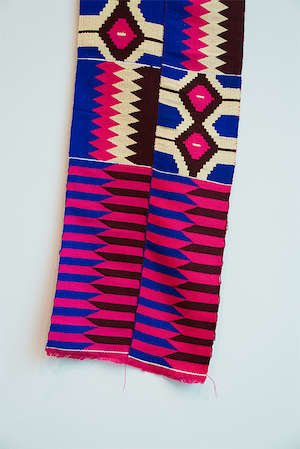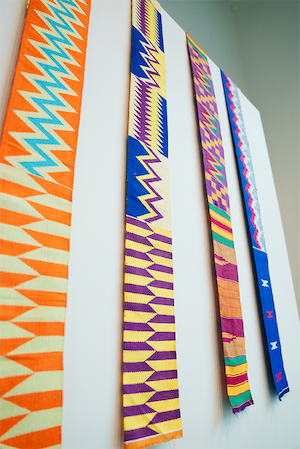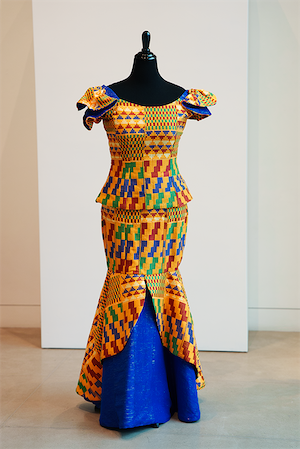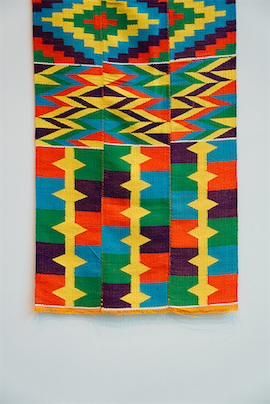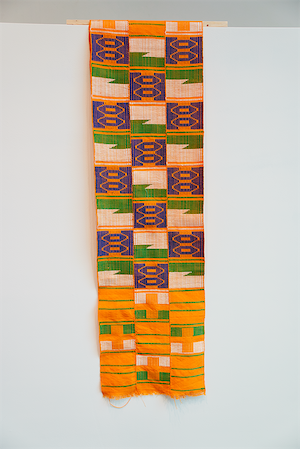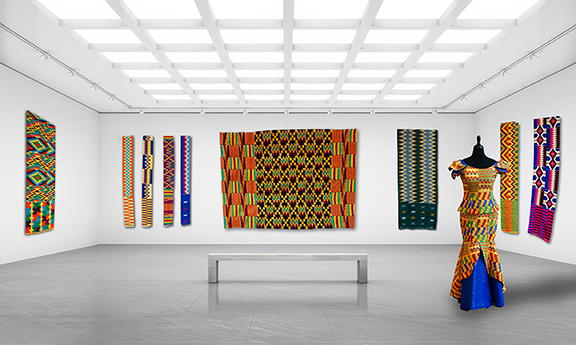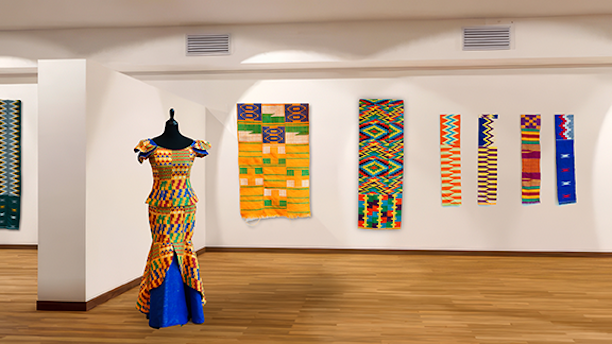The Legend of Kente
NEW!
“Wearing kente gives our African ancestry, traditions, and customs a new recognition, a new symbol, a new meaning, and a new relevance globally. It gives us the confidence and pride to walk in the way of our ancestors who have gone before us.”
—Dr. Gifty Afua Benson, collector, and curator
In its cultural context, kente is more than just a cloth. Like many of Africa’s visual art forms, kente is a representation of histories, folklore, philosophies, social values, and religious beliefs. The craftsmanship and cultural significance of authentic forms of the textiles have made them highly sought after and treasured by textile enthusiasts and fashion icons like Louis Vuitton and Vogue magazine.
While kente was originally reserved for use by royalty and limited to special social and sacred functions, it became popularized and liberally adopted by Black people across the African diaspora during the American civil rights movement of the 1960s. It is often used as a silent symbol in protests, graduation ceremonies, social and sacred functions, and wedding ceremonies.
Historically handwoven by the Asante and Ewe ethnic groups in present-day Ghana, kente cloth is heir to a long and rich historical and artisanal tradition. Kente is created using stripweave, an ancient textile technique, where narrow strips of handwoven cotton or silk are stitched together to form a whole finished cloth. Traditionally, Asante and Ewe men took on the role of weaving, using a wooden treadle loom to make long cloth strips before arranging them in an off-set manner of alternating patterns, resulting in a larger elaborate design.
The beauty of kente lies in the details. Each kente cloth has symbolism conveyed through contrasting colors, intricate patterns, and varying designs that have unique names and stories.
All kente is noted for its multicolored warp and weave patterns, and the designs are powerful cultural symbols that can be used as a non-verbal way of storytelling. Two of the most recognizable designs are Fathia Fata Nkrumah, named in 1958 to honor the wedding of Ghana’s prime minister, and The King Has Boarded the Ship, which tells the story of the Asante King Prempeh’s exile to Seychelles in 1896.
Once a royal textile whose use was carefully restricted, kente is now the national cloth of Ghana and an international symbol of pan-Africanism. Its distinct patterns and colors are even often incorporated into contemporary fashion, accessories, and home decor.
The Legend of Kente explores kente as legend and global icon, including over 50 kente weavings, four dresses, an illustrative “making kente” video, and interpretive materials that explore the meanings, symbols, and stories depicted by the weavers. The exhibition offers a multitude of programming opportunities, from weaving activities to creative expression through fashion, art, and community storytelling.
Exhibition Details
Over 50 textile weavings, 4 dresses, and one video (AV)
(A finalized checklist is in currently in development.)
-
Content
Fee Includes:
Press Kit
Registrar’s Packet
Programming Guide
Gallery Guide
Text Panels
Narrative Labels
Full Insurance
Installation Instructions
Custom-Designed and Built Crates -
Curated By
Dr. Gifty Afua Benson
-
Organized By
Mid-America Arts Alliance, ExhibitsUSA
-
Out-of-Region Rental Fee
$7,500
-
In-Region Rental Fee
$4,500
-
Duration
7-week display
-
Shipping
Van Line
-
Running Feet
TBD
-
Square Feet
-
-
Security
Standard
-
Number of Crates/Total Weight
TBD
-
Insurance
The exhibition is fully insured by ExhibitsUSA at no additional expense to you, both while installed and during transit.
Tour Schedule
The Legend of Kente is touring June 2026 through May 2031. The dates below reflect seven-week exhibition periods. Dates are subject to change; please contact MoreArt@maaa.org or (800) 473-3872 x208/209 for current availability.
-
June 16 - August 11, 2026
Griot Museum of Black History & Culture
St. Louis, MO pending -
September 1 - October 20, 2026
available -
November 10, 2026 - January 7, 2027
available -
January 28 - March 16, 2027
Historical and Cultural Society of Clay County
Moorhead, MN pending -
April 6 - May 25, 2027
available -
June 16 - August 11, 2027
available -
September 1, 2027- January 7, 2028
Irving Archives & Museum
Irving, TX pending -
January 28 - March 16, 2028
available -
April 6 - May 25, 2028
available -
June 16 - August 11, 2028
Refurbishment at Mid-America Arts Alliance
Kansas City, MO booked -
September 1 - October 20, 2028
available -
November 10, 2028 - January 7, 2029
available -
January 28 - March 16, 2029
available -
April 6 - May 25, 2029
available -
June 16 - August 11, 2029
available -
September 1 - October 20, 2029
available -
November 10, 2029 - January 7, 2030
available -
January 28 - March 16, 2030
available -
April 6 - May 25, 2030
available -
June 16 - August 11, 2030
available -
September 1 - October 20, 2030
available -
November 10, 2030 - January 7, 2031
available -
January 28 - March 16, 2031
available -
April 6 - May 25, 2031
available
Downloads & Resources
To view and download the factsheet for The Legend of Kente, click HERE.

